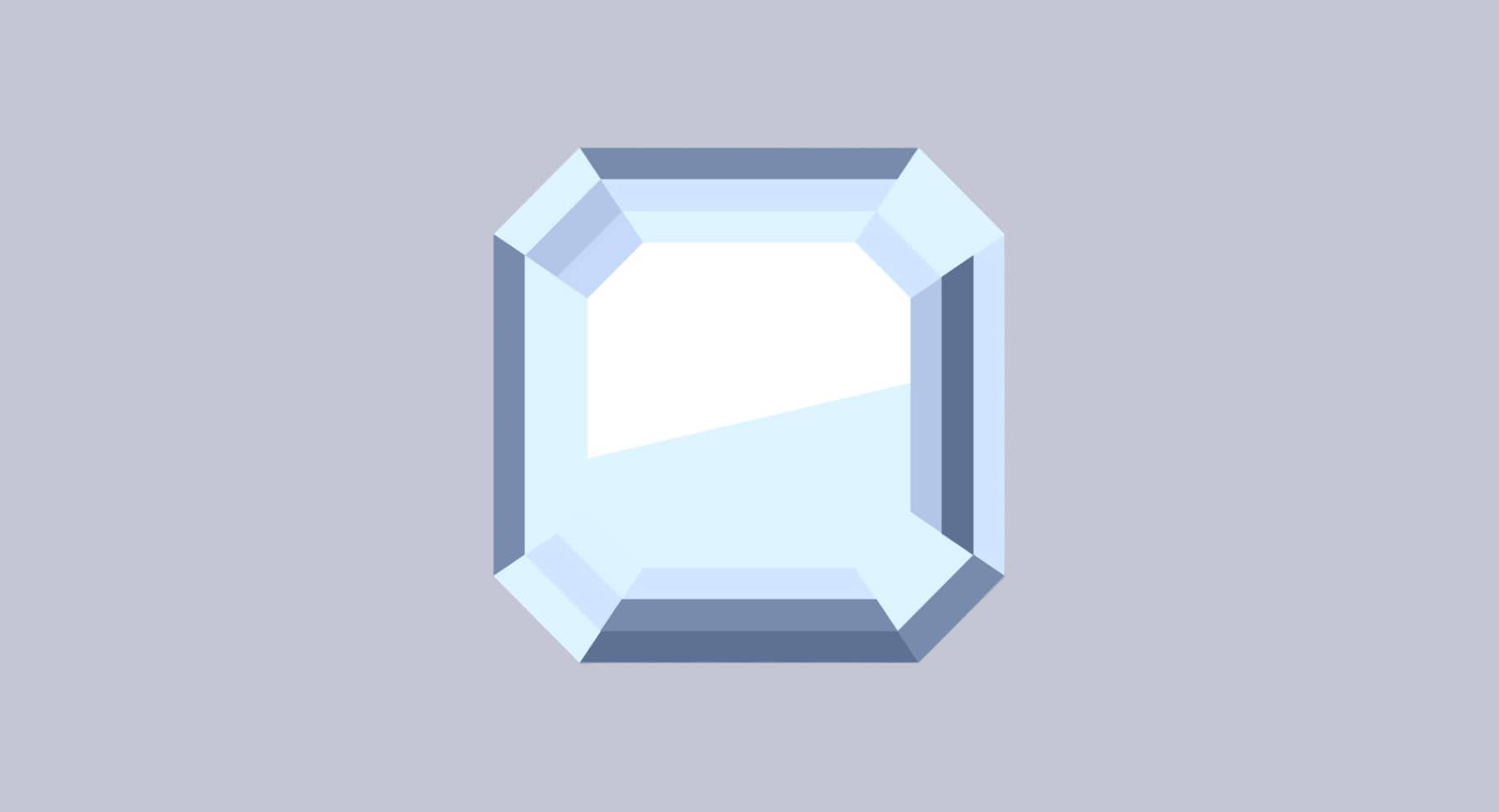The Asscher Cut diamond is technically Octagonal, but looks square when set in a 4-prong setting. Associated with the 1920s Art Deco style, it has enjoyed an understandable resurgence in the first part of the 21st Century.
Like an Emerald Cut, the Asscher Cut is a step cut diamond, meaning that it has parallel facets instead of kite-shaped facets, triangular facets, and star shaped facets, as in for example a Round Brilliant Cut.
Although there is some variation, almost all Asscher Cuts are a 58-facet version.
It has obvious appeal as a classy, elegant, edgy diamond engagement ring, with echos of F. Scott Fitzgerald, glamor, taste, and style.
Ready to dive into more information on this fascinating, elegant diamond cut?
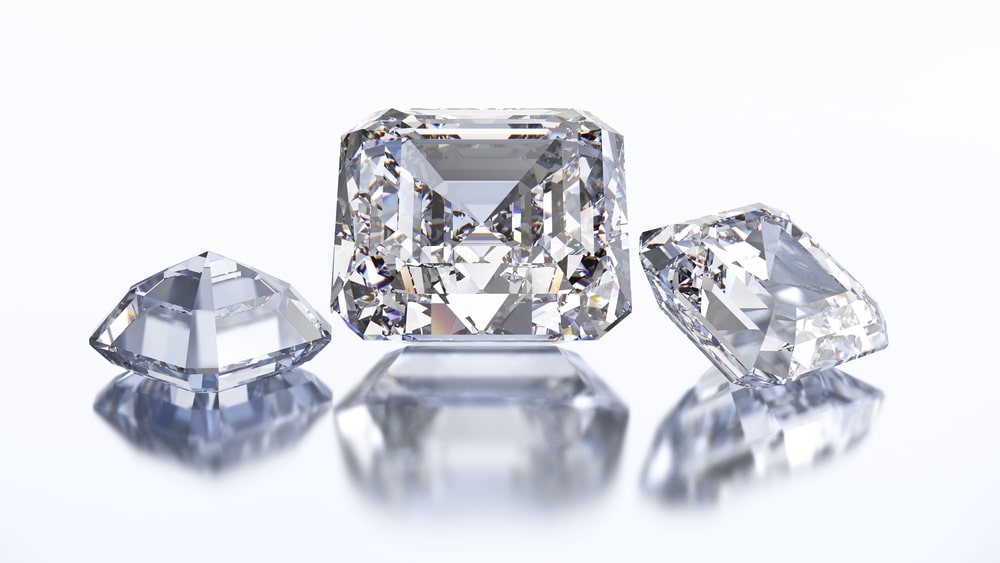
What You’ll Learn in This Article
When you finish reading this article, you’ll be able to answer all of the following questions about Asscher Cut diamonds.
- What does “Asscher” mean? Where did the name come from?
- What is the special history of the Asscher Cut Diamond?
- What Clarity grade of an Asscher Cut diamond should I choose?
- What is the relative cost of an Asscher Cut, compared to the usual Round Brilliant cut?
- Why is it surging in popularity in the 21st Century? Why do people like it?
- How can you judge the Cut quality of an Asscher Cut?
- How should you choose the Color in an Asscher Cut diamond?
- What setting can you choose to take full advantage of this Art Deco octagonal shape?
- What should you look for in an Asscher Cut diamond?
Why Is It Called an Asscher Cut?
Born in 1902, it came into its own in the 1920s
The Asscher Cut originated in 1902 in the work of Joseph Asscher, an Amsterdam, Holland, based diamond cutter for the Asscher Diamond Company.
Although the design was created for the first time in 1902, it did not surge in popularity until the post-war economic boom, celebration, and marriage boom of the 1920’s.
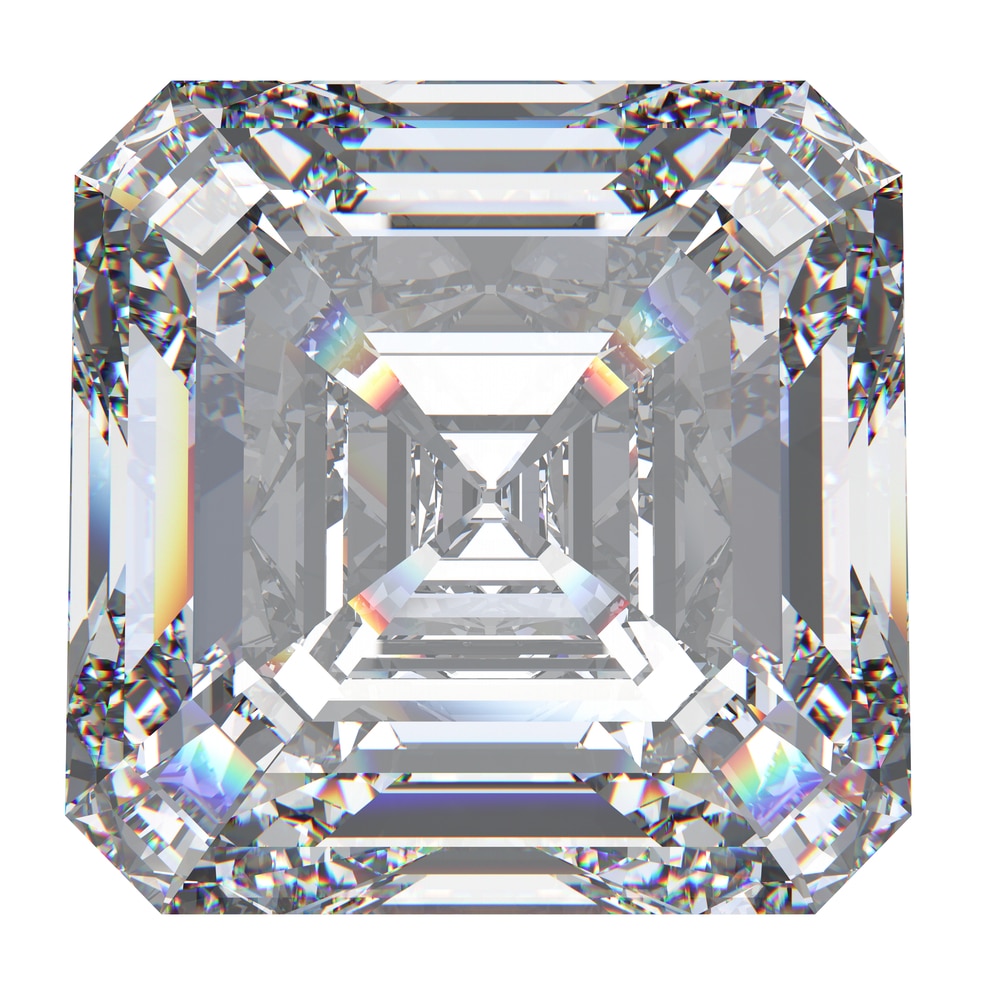
100-Year Anniversary and Rebirth
It surged again in the first decade of the 2000s. That’s when, upon its 100-year anniversary in 2002, it came to the attention of many people who for the first time in history were able to really see a wide variety of diamond shape inventory.
Previously, small local jewelry stores may have hesitated to stock Fancy shape diamonds.
Online shopping made it available to anyone with the taste and means
But with the advent of online shopping, online jewelry stores are able to stock and display enormous amounts and varieties of diamond inventory, including Asscher Cuts.
That’s especially true with the very recent, and constantly developing, advances in diamond imaging. When people see them, they love them.
The Asscher Cut 100-year anniversary, together with the rise of social media, have caused a rise in popularity that has only increased all the way up through the second decade of the 2000s.
It seems the Asscher Cut has established itself as a perennial choice for elegance, style, and 1920s panache in diamond engagement rings.
In addition to all of that, Edward Asscher, descendant of Joseph, has further improved this cut, making it more brilliant than before.
What Are Some Special Qualities That People Love About the Asscher Cut?
Here are some of the many reasons that Asscher cut diamonds are on the rise:
Distinctive Art Deco appearance
The Asscher Cut is unique among diamond cuts, since it has two sets of four equilateral sides (four long and four short), is a step cut, and has a deep pavilion.
The distinctive appearance of the equal length, parallel facets, and the extraordinary clarity they bring, makes it stand out even at a distance.
Brilliance
In addition, it’s quite brilliant with its 58 facets, as you can see from enjoying any of the imaging at James Allen or Blue Nile.
Two Apparent Shapes
It also has two distinctive looks:
- A square appearance when mounted in a 4-prong setting
- A fully Art Deco octagonal look when mounted in a halo setting
Note that it’s always the same actual shape: Octagonal. But in a 4-prong setting (see this one), it appears almost square like a Princess Cut.
But in this halo setting (have a look at this one), the octagonal shape is clearly visible, and fascinating.
Transparence Balanced with Brilliance
Step cuts such as the Asscher Cut (the other most popular step cut is the Emerald Cut) emphasize what we might call the transparence with brilliance.
Transparence is a different kind of beauty than brilliance, the beauty aimed for by the Round Brilliant Cut.
- Brilliance: a technical term for how much light a diamond reflects back out through the top of the gemstone. Most people prize diamonds for brilliance.
- Clarity: a technical term for expressing how few inclusions (flaws) a diamond has. In that sense it is one of the famous “Four Cs of diamonds”. But it’s also an everyday English term for how clear and transparent a diamond is.
- Transparence: an unofficial term for how easy it is to see through a diamond (even if it has flaws which would give it a low Clarity grade)
The Best of Both Worlds
When conditions are right for a stream to reflect maximum gleams of sunlight, you can’t see through the water. All you can see is the brilliance and fire from the sunlight reflecting off the water. A Round Brilliant Cut is like that.
Step cuts such as the Asscher cut create what connoisseurs of the Asscher Cut might call a happy medium between Brilliance and transparence.
Asscher cuts are quite brilliant. But they don’t overwhelm the eye with massive streams of light.
You can turn an Asscher Cut a little, and see either flashes of light or else you can see deeply into it, all the way to the culet (the bottom) of the diamond.
For those who love Asscher Cuts or other step cuts, this balance of transparency and brilliance is the best of both worlds.
How to Judge the Cut Quality of an Asscher Cut, Since the Gia Doesn’t Grade Fancy Shapes
Cut quality is different from Shape. This can be confusing because terms such as “Asscher Cut” and “Princess Cut” refer to specific shapes.
But Cut quality is literally how skillfully a diamond has been cut by a diamond cutter.
- How proportional it is.
- How symmetrical it is.
- How perfectly the facets are formed.
The result of a skillful Cut quality is to maximize brilliance through effective proportions, and to maximize symmetry and form.
The GIA (Gemological Institute of America) doesn’t grade the cut quality of Fancy shape diamonds, including Asscher Cuts. Which is to say, it grades the cut quality of only Round Brilliant Cut diamonds.
In fact, for Fancy shapes, there are no widely accepted mathematical or professional guidelines for Cut quality. It’s still an Old World, subjective quality of the human eye looking, feeling, experiencing.
You can learn this quickly. It’s not a skill available only to artists or geniuses. It’s just what you know you like, after you’ve spent some time comparing and contrasting, and experiencing.
You can evaluate Cut quality of Asscher Cut diamonds for yourself. Here’s what to look for:
Proportionality — Subjectively, Look for Diamonds That Please Your Sense of Proportion
- Observe the brilliance of various Asscher Cut diamonds.
“Good proportion” by definition, for many people, results in as much brilliance as you can find. By comparing the brilliance of many different specific Asscher Cut diamonds, you can get a good idea of what brilliance is possible.
Then you can use brilliance as one factor in judging proportionality. Is it quite brilliant for an Asscher Cut? Then it likely has good proportionality.
- The other factor is of course your sense of proportion of the form of the diamond. You can also develop your taste in form by comparing many different Asscher cut diamonds.
At James Allen or Blue Nile, where you can look at scores of diamonds, closely, very quickly, this development of your basic taste in form takes only a few minutes.
Brilliance
An Asscher Cut diamond, like any shape, should maximize its brilliance, according to what the shape is capable of.
Don’t expect an Asscher Cut to match the brilliance of a decent Round Brilliant Cut.
But expect the one you choose to be among the most brilliant Asscher Cut diamonds that you shop for.
Clarity
Look for two factors here. One is the technical aspect of Clarity: the lack of inclusions (flaws).
Be aware that an Asscher Cut shows inclusions (flaws) much more than a Round Brilliant Cut. A Round Brilliant Cut can hide many inclusions by its sheer brilliance. The amount of light pouring upward through the table (the top) obscures inclusions.
So don’t be too disappointed if you can see inclusions as you peer down through the table (top) of an Asscher Cut. It’s not the end of the world. Inclusions can even give an Asscher Cut some sense of depth, in the same way that a fish in a clear stream or aquarium can emphasize the depths of the transparent water.
If you want to pick one area in which to spend more money when shopping for an Asscher, then you may want to make that area the Clarity grade. Some inclusions (flaws) can be hidden in an Asscher, by chance. But the chances are much lower than in a Round Brilliant. Consequently, if you want to avoid seeing any inclusions at all, then you may need to shop for Asscher Cuts with GIA Clarity grades of at least VS2 or higher.
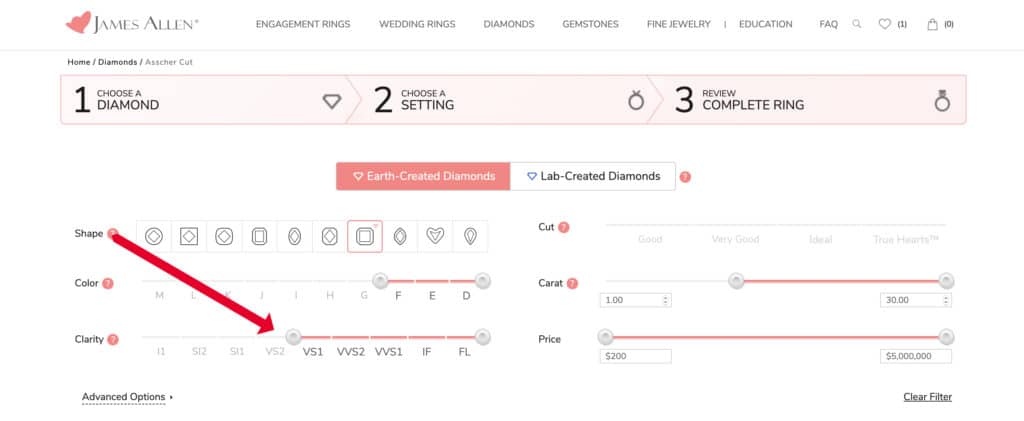
The second factor is a sense of transparency. Can you see clearly through the diamond, without distortion, or much distortion, right down to the culet (bottom) of the diamond?
(The GIA doesn’t grade for anything called transparency. That of course doesn’t meant that this pleasing quality does not exist. You can easily judge it for yourself.)
Do you see the signature Asscher “X” when you look down through the table (the top of the diamond)? See the below image for an example of what the “X” should look like.
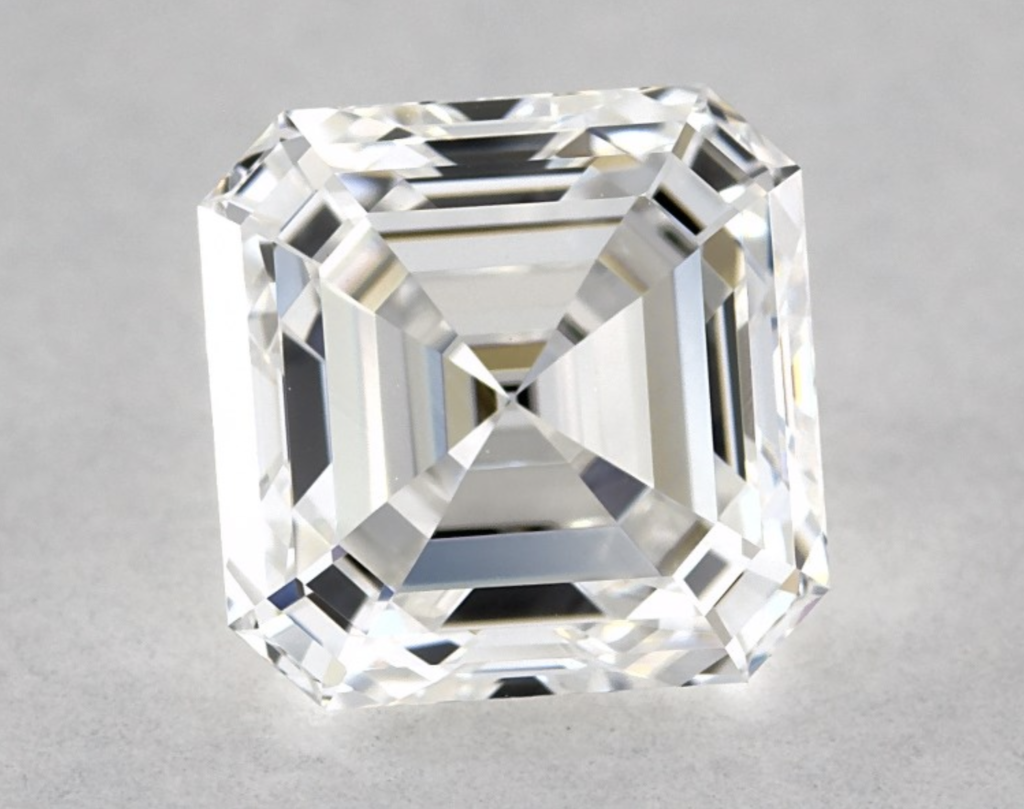
Clarity may be the principal quality that people prize about Asscher Cuts.
Color
Because Asscher Cuts have less brilliance than Round Brilliant diamonds, they show their true colors.
You can see the difference at James Allen or Blue Nile, if you compare Round Brilliant Cuts to Asscher Cuts of the same official GIA color grade.
Below you can see the color setting when choosing a color grade at James Allen.
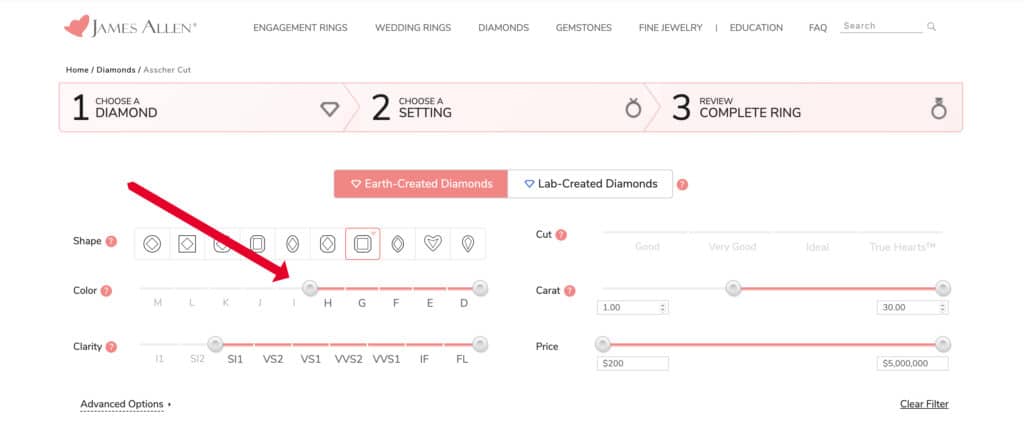
Because of the massive amounts of brilliants “bleaching” out their color, the Round Brilliant Cuts appear to have slightly better color for any given color grade. (Which is to say, of course, that they appear to be more colorless.)
For this reason, you may want to choose an Asscher Cut diamond with a GIA color grade of at least H.
Match Color Appropriately to Any Accent Diamonds
Because I recommend a Halo setting for those who want to maximally emphasize the octagonal shape of the Asscher Cut, I should also add a reminder here about choosing a color which matches your accent diamonds.
- Be sure to choose accent diamonds which don’t outshine the central Asscher Cut in terms of color. Accent Round Brilliant Cut diamonds of color H would look better than the Asscher color of H. That would cause the Asscher to look somewhat more yellow than it really is, by contrast.
- The solution to that possible dilemma is easy. Simply choose accent diamonds of one color grade below your central Asscher Cut. So, if your Asscher Cut central gemstone is of color H, then choose accent diamonds of color I.
Settings for Asscher Cut Diamond Engagement Rings
The beautiful thing about shopping online at James Allen or Blue Nile is that you can visually see exactly what a given diamond will look like in a given setting.
The online imaging at these two retailers make for a relaxing, enjoyable, no-pressure, almost addictive window shopping experience.
Two of the most popular settings for Asscher Cuts are:
- The 4-prong setting, which makes it look virtually square
- The Halo setting, which allows its octagonal shape to be emphasized.
The Halo setting will be more expensive, since the Halo is a cluster setting, requiring more diamonds to fill out the halo.
The 4-prong setting can be a solitaire, thus keeping down some expense, and showcasing this Art Deco masterpiece of a cut. So a 4-prong setting is also a striking setting for an Asscher Cut.
Buying an Asscher Cut Diamond
Diamond shopping doesn’t have to be intimidating.
Because you can spend unlimited amounts of time daily window shopping for diamonds, and because you have access to all the specifications, and all of the prices, you can become an aficionado in a very short amount of time.
Develop your own tastes. Comparison shop for various specifications that raise and lower the prices.
I can recommend the following highly-reputable, honest diamond retailers, with incredible imaging:
- James Allen
- Blue Nile
- Brian Gavin
Let me know what catches your eye, if you want my comments on it.
I’m happy to give my opinion, and happy even to guide you explicitly if that’s what you would prefer.
